
Data-Driven Learning.
Differentiated Training.

Data-Driven Learning.
Differentiated Training.
Student Resources
Easy Communication Tools
Here are some easy communication tools for you to use when speaking in English.
Remember to use simple easy words you know now.
Communication Dynamics
Speaking Bowling Style vs. Tennis Style
With the CoreComm Learning System, students learn Core Communication skills and techniques. Students learn the skills they need to communicate with Anybody, Anywhere, and Anytime. As an example, let's look at 'Bowling Style' and 'Tennis Style' conversations.
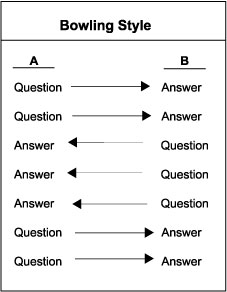
Bowling Style Conversation
Sadly, the 'Bowling' Style communication pattern is how many students speak English, even after studying English for a long time. When A asks B a question, B answers then stops. B expects A to continue asking questions. A often does. Then after A has asked all their questions on B's topic, B will begin asking questions about A's topic.
This style of communication is one sided and not really interactive, and it is not the normal style of conversation or communication that native English speakers use. It does happen, but not all the time. This style can be been seen in some situations, for example when a police officer is talking to a speeding driver:
Police Officer: "How fast were you going?”
Speeding Driver:?"I don't know.”
Police Officer:“Show me your license. What's your name?”
Speeding Driver:?"Bob Johnson.”
Police Officer:“What's your address?”
Speeding Driver:“ 21 Maple Street”
This kind of conversation style isn't very interactive and it is not the normal style of conversation between native English speakers. Yet, many ESL lessons teach this style or they teach a few sentences that students are expected to memorize and use in certain situations- this is called the Communicative Language Approach or English For Special Purposes (ESP). Students when taking tests with listening sections, or when talking to other English speakers often have trouble in a normal conversation, because normal conversations are more interactive. Let's take a look at what a more usual English conversation looks like, the‘Tennis’style conversation.
Tennis Style Conversations
'Tennis Style' conversations are often the more natural type of conversation that English speakers use. And this is the kind of conversation style that students are able to develop with the CoreComm Learning System.
In the 'Tennis' style conversation, A asks B a question about A's topic. B answers the question, then B asks A a question on B's topic. This continues and often, both topics are talked about at the same time. This kind of conversation is found on many English tests (i.e. TOEIC™ or TOEFL™). And many students have trouble listening to this kind of question, they also have trouble listening and talking in conversations with native English speakers.
Also, speakers may ask each other more than one question at the same time. So, normal conversations are a mixture of the 'Tennis' and 'Bowling' styles. This is one of the important core communication skills that students build with the CoreComm Learning System. The ability to use natural conversation styles, to be able to listen to and talk to Anybody, Anywhere, Anytime in Multiple Topic Environments (MTE).
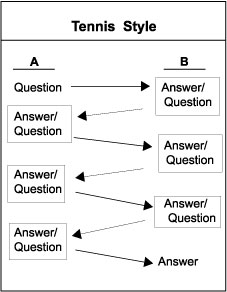
Parts of Speech
| Part of Speech | Function | example words | example sentence |
|---|---|---|---|
| Verb | Action or State | (to) be, have, do, like, work, sing, can, must | English is a fun language to learn. I like the CoreComm Learning System to learn English. |
| Noun | Thing or Person | pen, dog, work, music, city, Toronto, teacher, John | This is my dog. He lives in his own dog house. |
| Adjective | Describes a Noun | a/an, the, some, good, big, blue, well, interesting | That is a big dog. Do you like big dogs? |
| Adverb | Describes a Verb, Adjective or Adverb | quickly, silently, well, badly, very, really | My dog runs quickly. When he is very happy, he runs really quickly. |
| Promoun | Replaces a Noun | I, you, he, she, some, they | Hanako is Japanese. She is beautiful. |
| Prposition | Links a Noun to another word | to, at, after, on, but | They went to the office on Saturday. |
| Conjunction | Joins Clauses, Sentences or Words | and, but, when | I like tea and I like coffee. I like tea and coffee. I like tea but I don't like coffee. |
| Interjection | Short Exclamation sometimes inserted into a sentence | oh!, ouch!, Hi! / well.... |
Ouch! That hurts! Hi! How are you? Well, I'm not sure. |
| Part of Speech |
Function | example words |
example sentence |
|---|---|---|---|
| Verb | Action or State | (to) be, have, do, like, work, sing, can, must | English is a fun language to learn. I like the CoreComm Learning System to learn English. |
| Noun | Thing or Person | pen, dog, work, music, city, Toronto, teacher, John | This is my dog. He lives in his own dog house. |
| Adjective | Describes a Noun | a/an, the, some, good, big, blue, well, interesting | That is a big dog. Do you like big dogs? |
| Adverb | Describes a Verb, Adjective or Adverb | quickly, silently, well, badly, very, really | My dog runs quickly. When he is very happy, he runs really quickly. |
| Promoun | Replaces a Noun | I, you, he, she, some, they | Hanako is Japanese. She is beautiful. |
| Prposition | Links a Noun to another word | to, at, after, on, but | They went to the office on Saturday. |
| Conjunction | Joins Clauses, Sentences or Words | and, but, when | I like tea and I like coffee. I like tea and coffee. I like tea but I don't like coffee. |
| Interjection | Short Exclamation sometimes inserted into a sentence | oh!, ouch!, Hi! / well.... |
Ouch! That hurts! Hi! How are you? Well, I'm not sure. |
Verb Tenses
Past
Present
Future

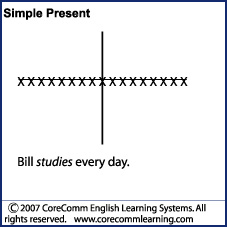

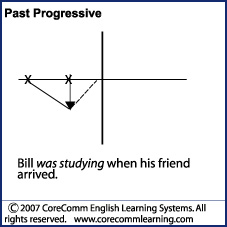
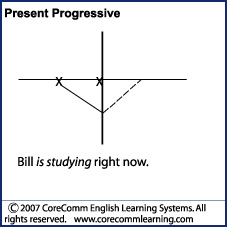


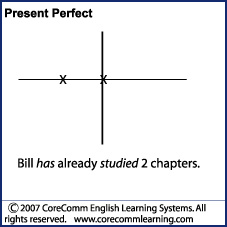

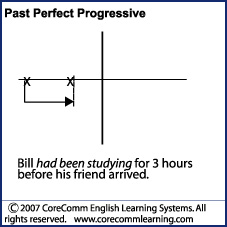
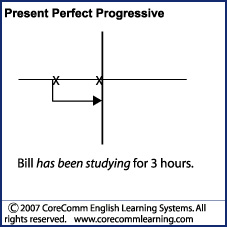

Prepositions of Place & Time
| Preposition | Use for | Examples |
|---|---|---|
| at | exact time/ place | 9:00 am/ one o'clock / midnight at Yokohama station/ at the office |
| on | exact date | Friday / Friday, January 1st |
| in | time period | May / Spring |
Examples of Prepositions in Use:
Let's meet at 9 am.
Let's meet at 9 am, on Friday.
Let's meet at 9 a.m., on Friday, April 7.
Let's meet in 4 weeks, on Friday, 7 April.
Let's meet in the Spring, on Friday, 7 April at my office.
Transitional Words & Phrases
| First | |
|---|---|
| Second | Than |
| And third | Next |
| After that | |
| Later | |
| And finally |
Ex
amples of Transition Words & Phrases
Transition words and phrases are very useful to connect your ideas and communicate them.
F
irst, go in the water. Second, put on your swim fins. And third, put on your diving mask and enjoy snorkeling.
First
, go in the water. Then, put on your swim fins, and finally put on your mask and enjoy snorkeling.
Adjective Order
| What the Adjective Describes |
Examples |
|---|---|
| Quantity | two, three, a few, several, many |
| Value / Opinion | delicious, wonderful, beautiful |
| Temperature | big, large, small, tall, short |
| Size | hot, warm, cool, cold |
| Age | new, young, old, 25 years old |
| Shape | triangle, square, round, flat |
| Colour | blue, red, green, yellow |
| Origin | Canadian, Japanese, |
| Material | steel, silk, wooden, plastic |
Examples of Multiple Adjective Use
There are three delicious chocolate cakes on the table.
It's a large new house. It has three beautiful large bedrooms, and hardwood floors.
She bought a beautiful old Japanese silk kimono.
The last three days have been wonderful, warm and sunny.
92% Less Time

CoreComm Takes 92% Less Time
Students using the CoreComm Learning System were able to achieve, an average 1 point increase in their TOEIC scores in just 26 minutes compared to 150 minutes for students using TOEIC study materials.
Students were able to increase their scores in just 8% of the time, compared to the students who used TOEIC study methods, that's a 92% Time Savings*.
Using the CoreComm Learning System, students achieved their goals faster and saved an average of $8,000* compared to other methods. How about you, would you like to improve your TOEIC score faster? Do you need to improve your communication skills now? Then contact CoreComm Learning Systems today.
* Individual results may vary.
CoreComm Learning System: Success Stories
Tanaka-san, an employee at a Japanese IT company, initially
struggled with English communication, impacting his TOEIC™ score and career
progression. Tanaka-san enrolled in the CoreComm course to address his
English language challenges.
The CoreComm course effectively addressed Tanaka-san's
English language barriers, transforming his approach to English communication
and opening new career opportunities in the IT sector.




I Don't Like English
On the first day of the class, Tanaka-san sat at the table with his arms crossed a sharp frown.He was asked, “Is communicating in English difficult?” “Yes, I don’t like it”. He was asked “Why?” The student said English vocabulary was difficult to remember, grammar was difficult and he couldn’t think in English, translating all the time was too troublesome! In addition, because of this, he couldn’t communicate well, he couldn’t improve his TOEIC™ score and so his career had stopped.He then took the CoreComm course and his situation changed.Results
On the last day, at the end of class, Tanaka-san came up to say good-bye to the trainer. He then shook the trainer’s hand, and would not stop shaking his hand. Tanaka-san said “Thank you, thank you so much. Last night, I experienced Japanese like a foreign language. I walked through my office, but I couldn’t understand my colleagues speaking Japanese. For the first time, I actually started thinking in English. Japanese was a foreign language to me- I've never experienced that before. Thank you."
Now I Can Think In English
"My whole life, my Japanese English teachers and my foreign English teachers said the same thing ‘Think in English, think in English’. But I didn’t know how. But now, I can do, I can think in English. Thank you” The trainer saw tears in Tanaka-san’s eyes. Tears of joy and confidence.He said that he could now think directly in English. This made using English much easier for him. He also said the he now had the communication skills to talk to others more confidently and that he could re-start his career.
For a free consultation on how your organization can start
to develop a focused and measured training program, contact CoreComm Learning
Systems today.
Study Hours Needed
Estimated Hours of Study Needed to Progress between TOEIC levels using TOEIC materials
| TOEIC 200 | TOEIC 300 | TOEIC 400 | TOEIC 500 | TOEIC 600 | TOIEC 700 | TOEIC 800 | TOEIC 900 |
|---|---|---|---|---|---|---|---|
| 100 | 250 | 450 | 700 | 1000 | 1350 | 1750 | |
| 150 | 350 | 600 | 900 | 1250 | 1650 | ||
| 200 | 450 | 750 | 1100 | 1500 | |||
| 250 | 550 | 900 | 1300 | ||||
| 300 | 650 | 1050 | |||||
| 350 | 750 | ||||||
| 400 |
| TOEIC 200 |
TOEIC 300 |
TOEIC 400 |
TOEIC 500 |
TOEIC 600 |
TOIEC 700 |
TOEIC 800 |
TOEIC 900 |
|---|---|---|---|---|---|---|---|
| 100 | 250 | 450 | 700 | 1000 | 1350 | 1750 | |
| 150 | 350 | 600 | 900 | 1250 | 1650 | ||
| 200 | 450 | 750 | 1100 | 1500 | |||
| 250 | 550 | 900 | 1300 | ||||
| 300 | 650 | 1050 | |||||
| 350 | 750 | ||||||
| 400 |
* Individual results may vary.
Estimated Hours of Study Needed to Progress between TOEIC levels using TOEIC materials*.
Average toeic test score increase*
increased
fluency speed
Increased
reading speed
listening & Pronunciation improvement
*Individual results may vary

Students using the CoreComm Learning System were able to achieve an average of 150 point increase on their TOEIC scores in just 12% of the time, compared to students who used other TOEIC study methods.
CoreComm helped students achieve an average 150 point increase 88% faster. CoreComm saved students 92% in study time and an average $8,000*.
How about you, would you like to improve your TOEIC and other language test scores faster?
Do you need to improve your communication skills now? Then CoreComm Learning Systems to schedule a course today.
* Individual results may vary.

CoreComm Learning is here to provide you with more information, answer any questions you may have and help you create an effective training solution to help you develop your Global Communication skills today.
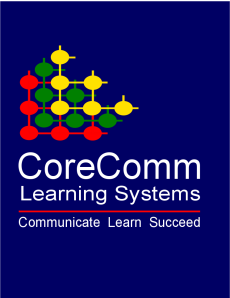
Contact us today